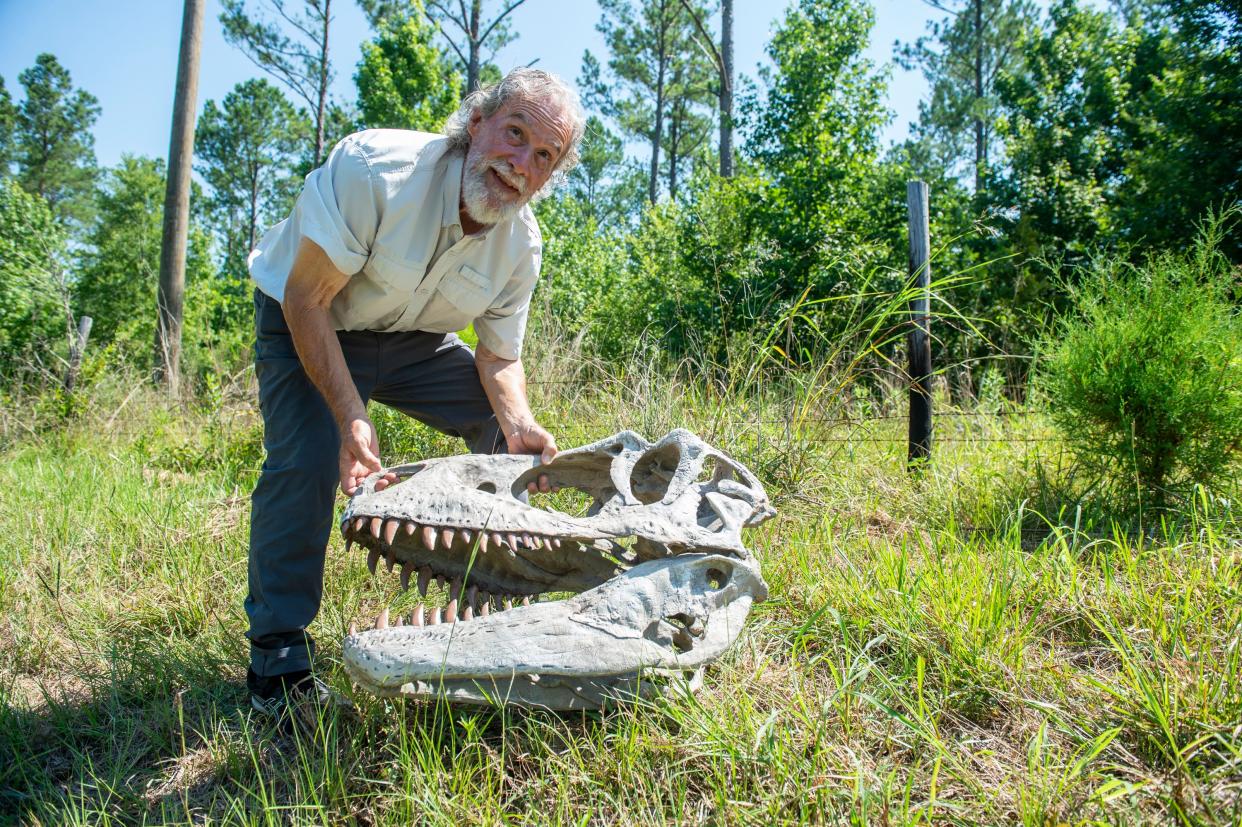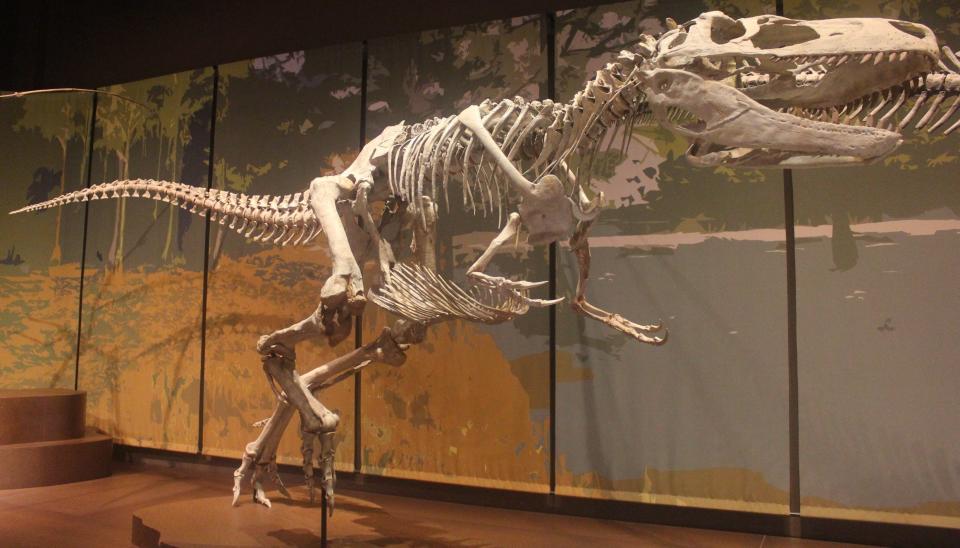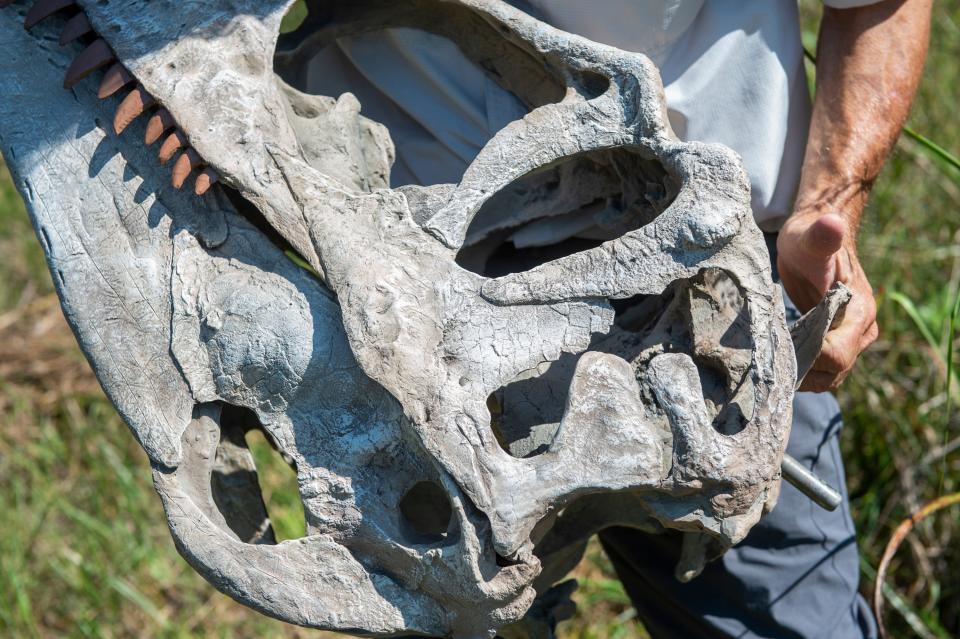Answer Man: Did dinosaurs roam Asheville land? How many? How long were they here?

Today's question is about dinosaurs, and if any roamed the land where Asheville now is. Have a question for Answer Man or Answer Woman? Email Executive Editor Karen Chávez at KChavez@citizentimes.com and your question could appear in an upcoming column.
Question: Ever since I was a kid, I’ve had a fascination with dinosaurs. I was wondering if dinosaurs roamed the land where Asheville is now. If so, what kind? How many were there? How long were they here?
Answer: Maverick paleontologist Bob Bakker is fond of saying that dinosaurs are nature’s special effects. During the Mesozoic Era, dinosaurs dominated life on Earth. Their domain stretched from the Gobi Desert to the tip of Patagonia and north to the frozen climes of Alaska. During the Late Cretaceous, about 75 million years ago, dinosaurs of all shapes and sizes could be seen roaming the terrain that is now Asheville.
The prehistoric world was an alien land, one that looked and sounded very unfamiliar. We are used to seeing grass cover our hills and plains, but grasses would not evolve for another 10-15 million years. Instead, Asheville’s low-lying ferns helped to prevent soil erosion as well as provide nutrients for herbivorous dinosaurs such as Leptoceratops, a small hornless (6 feet long) cousin of Triceratops, the three-horned gladiator of the Late Cretaceous.
More: Answer Man: Are number of coyotes increasing in WNC? Do they threaten humans?
More: Answer Man: What's the latest on Amtrak expanding to Asheville?
Made famous by Hollywood, long-necked dreadnoughts like Brachiosaurs (the first dinosaur seen in "Jurassic Park") had died out in North America. One exception was the Alamosaurus from Texas, the last of the prehistoric titans. But there’s no fossil evidence of these giant animals ever having roamed the plains of North Carolina.

North America was divided by an inland sea. To the west of the divide was Laramidia with the richest fossil beds in the country. On the other side stood Appalachia. Its wildlife was not as diverse or spectacular as Laramidia’s, but prehistoric Asheville’s proximity to sea meant that flocks of winged predators, called pterosaurs, were a common sight. The bat-like flying reptiles patrolled the skies above Asheville and swooped down to scoop up unwary fish from the water’s surface.
Prehistoric Asheville abounded with danger. Around this time, some 75 million years ago, the apex predator of the Carolinas was a cousin of the more famous T-Rex. It was a 30-foot-long killer with a mouth filled with 60 lethal dagger-like teeth.
More: Answer Woman: How big of a risk are falling trees in Asheville? City response to concerns?
More: Answer Woman: Branches leaning against powerlines? Who is responsible for tree trimming?
Appalachiosaurus would have been a fast runner over short distances and may have been an ambush predator. Its eyes did not face sideways like modern reptiles but forward, giving the creature excellent depth perception to visually map out its attack.
Appalachiosaurus was armed with speed, bipedal maneuverability, and powerful jaws capable of delivering a bite of 7,200 pounds per square inch, which is five times more powerful than the bite of a bull shark. Unlike earlier predators, Appalachiosaurus was not a slasher, like the Allosaurus of the Jurassic Era. Its teeth had evolved not merely as cutting tools but as lethal weapons designed to crush living bone.

The sight of Appalachiosaurus would have terrified its most likely prey, a duckbilled dinosaur called Hysibema, discovered in Sampson County in 1869. Like other duckbills, it sported no defensive weapons and was slow and clumsy. Unable to outrun or outfight their enemy, duckbills lived in herds as numbers provided their only safety. Being a large herbivore, Hysibema would have been migratory as a herd could defoliate a grazing area in a matter of a few hours. Fossilized trackways of duckbills show that they traveled in large numbers and were constantly on the move in search of food. It would not be uncommon to see duckbills migrating along the game trails of Mesozoic Asheville, and perhaps being stalked by a pack of wiley Appalachiosaurs.
More: Answer Woman: What's the oldest restaurant in Asheville?
More: Answer Man: What's the backstory of ‘French Broad Hospital’ off Hilliard Avenue?
The dinosaurs’ reign came to an end around 66 million years ago when an 8-mile-wide asteroid crashed into the Yucatan Peninsula and created an explosion equal to 100 trillion tons of TNT. The impact sent up clouds of dust that blocked out the sun for months. Years of darkness and cold followed. The herbivores not killed by the impact would have died out with the plant life that once sustained them. Like modern reptiles, the remaining carnivores would have resorted to cannibalism until there no more prey existed and they, too, perished.
Dinosaurs left us with more than their bones. We have found their trackways, tail feathers preserved in amber, and hundreds of unhatched eggs provide testimony to how the dinosaurs lived when they ruled the earth, a domain that included what is now Asheville.
This article originally appeared on Asheville Citizen Times: Answer Man: Did dinosaurs roam Asheville land? How many? How long?

